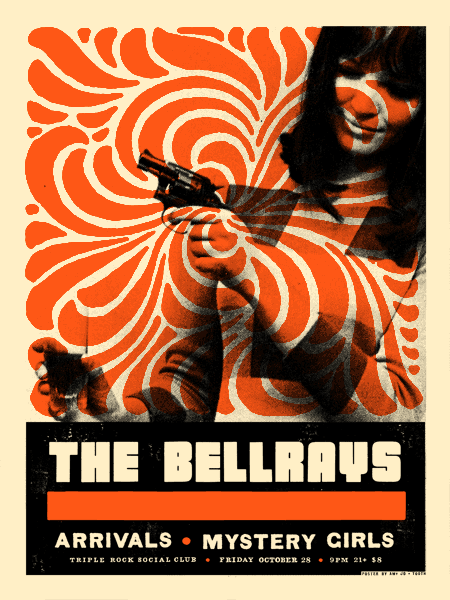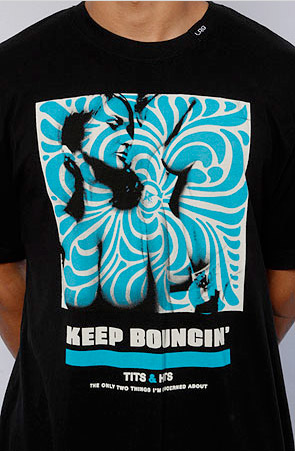The marketplace of (other people’s?) ideas
The blog of Burlesque Of North America pointed out the following a little while back. Here is a poster (amoxicillin) designed by Minneapolis artist Amy Jo (who you may recall is one of the folks I hired to create a promo poster for Buying In), back in 2005:

And here is a T-shirt from LRG, in 2009 :

I’m not in the business, of course, but it’s hard for me to believe that the designer of the latter just coincidentally came up with that psychedelic swirl/flower pattern, among other similarities. (And yes there are differences — the LRG shirt in my opinion is pretty sophomoric compared to the more-striking Amy Jo effort.) And I was actually surprised to see that one of the comments on the Burlesque of North America blog linked to this Frank 151 item alleging LRG had lifted another design, from Sailor Jerry, and claiming that “they have done this several other times.”
To be clear, I’m not making any allegations myself, as I have no idea what LRG’s side of the story might be. As you probably know, a variety of similar instances involving big companies and indie creators are explored on the (cytotec) site You Thought We Wouldn’t Notice. Often the posts there come from creators who feel ripped off.
A prominent theory of Web-thought is that such exposure ought to spark some kind of response and ideally resolution of the specific instances — and, you would think, a downtick in the number of such instances. And yet it seems routine. And it looks like LRG didn’t even respond to the allegations on either the Burlesque of North America blog, or on Frank151. Aren’t there swarms of social-media consultants out there claiming that companies have to seek out and address complaints and allegations — whether they come from the creator, or from a third-party observer — or suffer marketplace consequences? Is that theory true or not?
Or does a creator who feels aggrieved have to do what Jenny Hart did and file a lawsuit*? I don’t want to get sued myself, so let me just be clear, again, that I really do not know enough about copyright law to say how the various allegations noted above would fare in the legal system. And maybe there (priligy) are explanations — maybe LRG, for example, has some plausible reason for the apparent similarities between their designs and Amy Jo’s, and Sailor Jerry’s. If so, you’d think that they’d want to say so in public. But maybe in real life, despite what the social-media folks say, it’s easier for them to just ignore it?
[*10/24 update: I originally wrote that Hart “sued,” but that’s technically wrong as the suit was filed, but not served. My apologies. I’ll follow up later on this to set the record straight in a clearer way.]




 "
"












 Kim Fellner's book
Kim Fellner's book  A
A
Reader Comments
I love SYTWWN. Big fan. Keeps people honest. It really is amazing how brazen companies are and they’re quite shameless and feel no embarrassment when publicly exposed.
I was recently a victim of the site though! My husband shot a campaign for Visa and some posters claimed that the idea was ripped from student work from an obscure college. Having been privy to the reference material, it’s true it was referenced but certainly not to student work. We rebuked saying it was a stretch and that we had authority in the matter and the moderators kindly removed it. So all in all, it is a great system. If only it was more official.
Rebecca.
Interesting. There is kind of a wild-west quality to it, and I guess that can lead to problems. At least y’all responded, though. It’s interesting to think about how to make it more official, per se. Hm.
I think that in the “streetwear” world it’s pretty common to completely rip images with only a mild twist. See Supreme, FreshJive, and Crooks N Castles as particularly horrendous offenders. Although, I believe Supreme usually gets permission.
There’s a big difference between going “up” (small streetwear brand riffs on mainstream logo) and “down” (mainstream company borrows graphic ideas from indie artist) in this sort of thing. Among other things, there’s no referencing going on in the latter category — it’s just taking someone’s idea and pretending it’s yours. (Nobody thinks Freshjive came up with the design of the Tide logo or whatever — it’s a remix/riff, etc.)
The other big difference is that if a mainstream mark-owner feels ripped off by an indie brand, they can just send out the lawyers. In the reverse situation, that’s not true.
So to me it’s completely different.
Anyway though, you’re right, that Supreme does get permission, from what I know anyway.